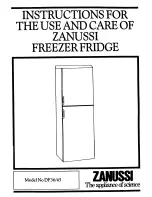
DEFROSTING
A) FRIDGE COMPARTMENT
The fridge compartment defrosts
automatically. The defrosting water runs
to the drain tube via a collection
container at the back of the appliance (1).
(see diagram)
During defrosting water droplets may form
at the back of the fridge compartment
where concealed evaporator is located.
Some droplets may remain on the liner and
refreeze when defrosting is completed. Do
not use pointed or sharp edged objects such as knives, forks to remove the droplets
which have frozen.
If at any time the defrost water does not drain from the collection channel, check
to ensure that no food particles have blocked the drain tube. The drain tube can
be cleared by pushing the special plastic plunger provided down the drain tube
(2). If the frost layer reaches about 1/4"(7 mm), reduce the setting (i.e. from 4 to
1) to restart automatic defrosting.
B) FREEZER COMPARTMENT
Defrosting is very easy and without mess
thanks to a special defrost collection basin.
Defrost twice a year or when a frost layer
of around 7 mm (1/4") has formed.
To start defrosting procedure switch off the
appliance at the socket outlet and pull out
the mains plug.
All food should be wrapped in several
layers of newspaper and stored in a cool
place (e.g. fridge or larder).
Remove all freezer dravers.
Containers full of warm water may be placed carefully in the freezer to speed up
the defrosting.
Do not use pointed or sharp edged objects such as knives, forks
to remove the frost.
Never use hairdryers, electrical heaters and other similar
electrical appliances for defrosting.
When defrosting has finished, sponge out any defrost water which collects at the
bottom of the freezer and dry the interior thoroughly. Insert the plug in to the wall
socket and switch on the electricity supply.
CLEANING AND CARE
** We recommend that you switch off the appliance at the socket outlet and pull
out the mains plug before cleaning.
** Never use any sharp abrasive instrument, soap, household cleaner, detergent
and wax polish for cleaning.
** Use luke warm water to clean the cabinet of the appliance and wipe it dry.
** Use a damp cloth wrung out in a solution of one teaspoon of bicarbonate of
soda to one pint of water to clean the interior and wipe it dry.
** Make sure that no water enters the lamp housing.
** Excess deposits of ice should be removed on a regular basis with the handle of
a spoon. Large accumulation of ice will impair the performance of the
appliance.
** If the appliance is not going to be used for a long period of time switch it off,
remove all food, clean it and leave the door ajar.
** Any dust that gathers on the condenser, which is located at the back of the
appliance, should be removed once a year with a vacuum cleaner.
** Check door seals regularly to ensure they are clean and free from food
particles.
** Removal of door tray
• To remove door racks, remove all the contents and then simply push the
door rack upwards from the base.
** To remove a freezer drawer, pull it as far as possible, and then tilt it upwards,
and then pull it out completely.
** To remove the freezer flap door, first open the door 3” and then gently pull it
off. Make sure that the flap is in place before closing the freezer door.
** Make sure that the special plastic container (drain tray) at the back of the
appliance which collects defrost water is clean at all times. If you want to remove
the tray to clean it follow the instructions below :
• Switch off at the socket outlet and pull out the mains plug.
• Push the lug down with the tip of a screw driver & pull out with a jerk movement
• Clean the drain tray and wipe it dry.
• Reassemble reversing the sequence and operations.
13
14
(1)
(2)
Drain Tube
Defrost
Water
Collection
Содержание B-750CDA644
Страница 1: ......





























